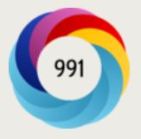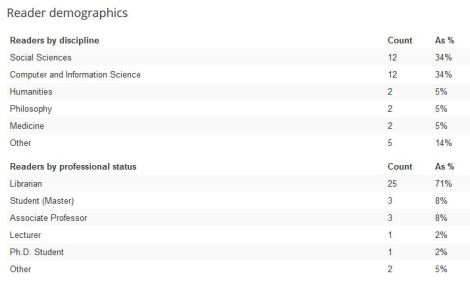In my previous post I very briefly mentioned the idea of alternative metrics in relation to the TAGS application. Since then in our DITA lab sessions we have had the chance to dig further into altmetrics and experiment with another very interesting application, the Altmetric Explorer, courtesy of London based start-up Altmetric. In their words:
The Altmetric Explorer lets you monitor, search and measure conversations about your publications and those of your competitors. Use the Explorer to deliver insights, track mentions and measure levels of attention over time.
It does this by amalgamating mentions for articles from various sources – e.g. Twitter, blogs, Facebook and various news outlets – and then assigning a weighted score based on the amount of attention an article has received. The information created is then offered in several ways, with the (potentially) iconic donut visualisation taking centre-stage, allowing you to quickly see which sources have offered the most impact based on their assigned colour-code:
To experiment with the Explorer I thought I might as well kill two birds with one stone and search for articles relating to my chosen DITA essay topic. As I will be looking into the implementation of discovery tools/platforms (such as Primo) by libraries, I searched using the keywords ‘discovery tools’, with the subject field ‘Library and Information Studies‘. This resulted in a list of 81 articles, with a not particularly impressive Altmetric score of 24 for the top article.
In terms of measuring impact on an initial, very shallow, level this could perhaps be seen to demonstrate a fairly low level of interest in the articles listed, and therefore in the topic of discovery tools generally. I should mention here though that some of the results were not relevant for my ‘information needs’, whereby not all of the articles were actually referring to discovery tools specifically (or ‘platforms’ or ‘layers’ – there are several different names!). This was potentially a result of keeping my search terms relatively broad and unstructured, in an effort to maximise my search results.
However for this initial experiment I only wanted a small dataset anyway, and within the results there were definitely some very useful articles, not only in terms of researching for my essay but also for thinking about what the Explorer offers. Taking one relevant resulting article as an example – ‘A Student Perspective on e-Resource Discovery: Has the Google Factor Changed Publisher Platform Searching Forever?’ – the Altmetric score may have only been nine (based on one blog mention and one Facebook mention) but I found the demographics tab, based on information from reference manager Mendeley, of potential interest:
Again I must stress the basic level of my analysis here and acknowledge the limitations of the sample size featured, but at a glance this feature allows you to gain a quick picture of the range of people interested in a particular article. Given the article’s source (The Serials Librarian: From the Printed Page to the Digital Age) it is of course not surprising that the majority of readers in this case are identified as librarians (71%), but on top of this there is an apparent spread across identified disciplines, and also a few other professions listed. This could perhaps show a broader interest in the topic than might be expected, and lead to further questions about how research is received and disseminated across different domains.
Our DITA assignment requires us to consider how we can evaluate a chosen Digital Technology and whether or not it is successful in meeting a particular LIS need, so playing with the Explorer got me thinking about not only finding popular and useful articles for my research, but also about the interaction between ‘technologies’ and how they can be used to evaluate each other (through APIs and mashups for example). As it happens Ex Libris have offered an add-on for their aforementioned Primo discovery tool that allows scores from Altmetric to be embedded in search results – something I hope to explore further in my assignment.
At the moment, as with many of the ideas we have covered so far in DITA, I feel I have only scratched the surface of altmetrics, and there are certainly many more applications and uses for the data created than those I have mentioned. My coursemates have been discussing the benefits and issues surrounding altmetrics in various interesting ways in their recent blog posts, which you can find here.
It is currently hard to predict what the long-term impact of the products and services offered by companies such as Altmetric will be as they are still relatively new, and many in the academic world have expressed caution about their use, with a concern about the lack of deeper qualitative information provided (see this article for example). However the fact that more and more institutions and organisations are now utilising them, and building bridges between applications, suggests that they won’t be going away anytime soon and they will continue to grow and advance.
As an aspiring information professional I would definitely say that it makes sense to build and maintain an awareness of developments in this area, and to think about how this can impact, and potentially improve, the services libraries offer. In the library where I work this has been reflected with a recent page on our IOE LibGuides acknowledging the emergence of altmetrics, and listing not just Altmetric but also several other examples of competing tools now available.
In my next post I’ll be discussing my efforts to dig even further into the datasets created with both TAGS and the Altmetric Explorer, using some beginner’s text analysis and playing with visualisations…
Screenshots and data courtesy of http://www.altmetric.com, from 18/11/14.

